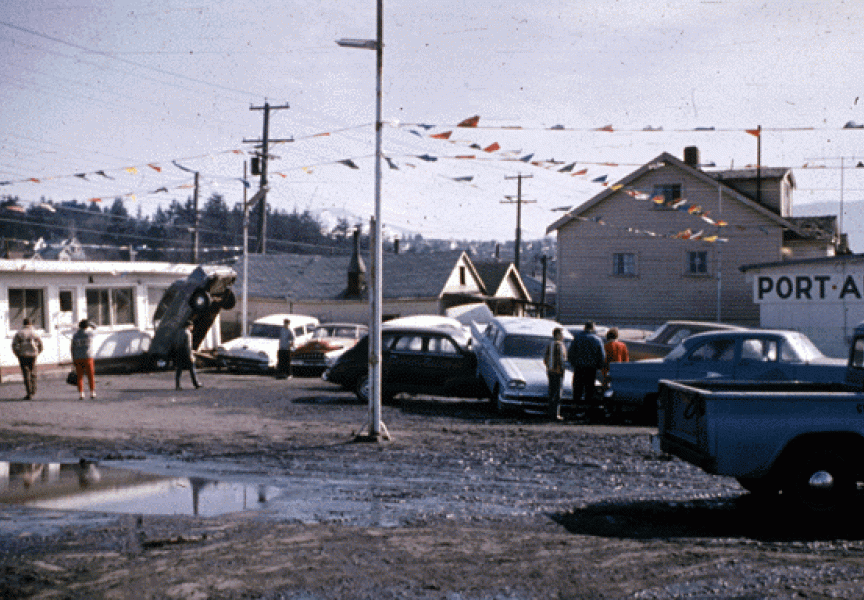Surviving a Disaster is Everyone’s Business
Week 26: Add to ONE container: mirror (f desired), razor and shaving cream (if desired); cotton swabs, sore throat lozenges, hydrogen peroxide, alcohol, bandages, adhesive tape.
Week 25: Add to ONE container: battery-operated radio with extra batteries and favourite family book(s).
Week 24: Add to ONE container: sunscreen, insect repellent, hand lotion, fingernail clippers, nail file, small bottle of aspirin, Tylenol or Advil:
Week 23: Add to ONE container: 10-20 foot length of rope, water purification tablets or medicine dropper, small bottle of lquid chlorine bleach (odourless) dust masks and eye protectors.
Week 22: For each family member, add: 1 can baked beans, 1 can spaghetti in sauce and 3 fruit rolls or fruit leather.
Week 21: For each family member, add: 1 package rice cakes, paper and pencil, 1 small game (Uno, etc). Fill out medical release form for each minor child in family and put in appropriate containers.
Week 20: Add to ONE container: waterproof matches, solid standing candle, 1 small pocketknife or paring knife.
Week 19: For each family member add: 6 individually wrapped moistened wipes, 15 paper towels and toilet paper.
Week 18: For each family member, add: 1 lip balm, spare eyeglasses, 10 quarters for phone calls, one lightweight foil blanket.
Week 17: For each family member add: 6 safety pins of assorted sizes, 1 towel, 1 washcloth, 1 bar of soap, a soap dish and battery operated watch or clock.
Week 16: For each family member add: brush and/or comb, tooth brush, toothpaste, shampoo, deodorant, flashlight and batteries.
Week 15: If you have an infant in your family, you need to create an infant disaster kit that might contain: disposable diapers, baby wipes and diaper rash cream, baby soap, formula, disposable bottles and nipples, warm sleeper, warm blanket, hooded jacket, baby food for seven days, crackers, pacifier, teether, baby medications (as needed), Vaseline, changes of clothing, duplicates of favorite toys.
Week 14: For each family member, add: bedding. This could be a sleeping bag or two blankets, two cloth sheets and two plastic sheets for ground cover. In practicing your family evacuation drill, train family members to quickly roll up sheets and blankets together as they get out of bed and bring these with them as they leave their rooms.
Week 13: For each family member, add: 1 package of trail mix, 1 can vegetables and a seven day supply of vitamin mineral tablets.
Week 12: For each family member, add 3 sticks jerky and 3 cans fruit (applesauce, peaches, pears, etc.).
Week 11: For each family member, add to your emergency kit 1/2 pound of instant powedered milk, 1 envelope powdered juice drink, 1 can evaporated milk (120 ml), 1 container "shelf" milk (500 ml).
Week 10: Store four litres (one gallon) of WATER per person per day (include additional water for any pets).
Week 9: For each family member, add to your emergency kit: underwear, socks, shirt, pants, sweater, hat, work golves (for those who might be helping with clean-up), jacket and sturdy shoes.
Week 8: For each family member add to your emergency kit 1 small package of tissues, 1 can of nuts (almonds, peanuts, cashews, sunflower seeds, etc.), small containers of nut butter (peanut, almond, cashew, etc) and honey, jam,salt, pepper and sugar.
Week 7: For each family member add to your emergency kit: 2 large plastic bags (to be used as a poncho, ground cover, blanket, or for trash, waste or water protection), 6 medium plastic bags, a plastic cup and dish and 6 to 10 small paper plates.
Week 6: For each family member, add to your emergency kit: 3 granola bars, 3 juice boxes, (apple, orange or tomato) which are vacuum sealed, in a waxed container with a drinking straw.
Week 5: Plan and practice family evacuations drills using two different escape routes from each room and meeting at a pre-appointed location. Consider placing an escape ladder on the second floor of a two-storey home. For each family member add to your kit containers: 1 small can opener, 1 can prepared meat and 1 box/package raisins or other dried fruit.
Week 4: It's time to add to your disaster kit containers. For each family member add: 1 can soup, 3 small packages of crackers and eating utensils (knife, fork and spoon). Remember: You must consider any special dietary needs that any family members have.
Week 3: Post emergency phone numbers near each telephone and instruct all family members on the use of these numbers. Designate the number of a relative or friend who lives outside the province as your family's contact. After the disaster, it is often easier to call out of the region as the local phone lines might be tied up. Also, post your address and telephone number near each phone. This will assist you during a traumatic event if you need to call 9-1-1.
Week 2: Create a menu for every meal for every day taking into account special food needs and food allergies. Then use the menu to determine what food items you need to include in your disaster kit. (editor's note: Plan for a minimum 72 hours, or if living remote as much as a week. Help might not be able to get to you for some time, depending on the need in more urban areas.)
Week 1: Get Disaster Kit Containers: You can either use a separate container for each member of the family or a number of larger containers to use for the family as a whole (plastic bucket, backpack, suitcase, box etc.) If you use a separate container for each member of the family, designate one container as the “main” container as some weeks you will be adding items only to one container. Find an accessible location to store the containers (one which is close to an exit) and inform all family members of their location.
For more information on Emergency Preparedness, visit the Alberni-Clayoquot Regional District website at www.acrd.bc.ca



